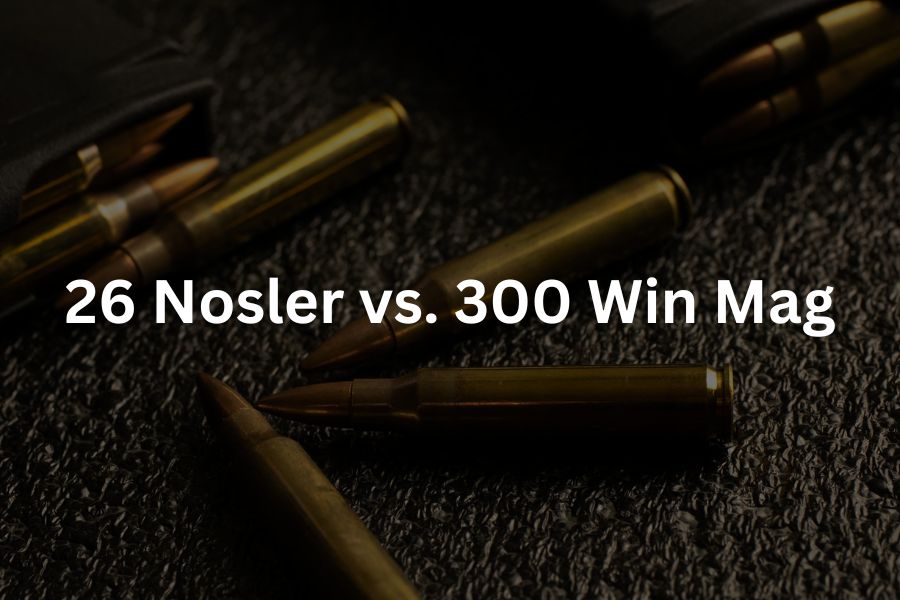When it comes to long-range hunting cartridges, there are many options available. Two popular choices among hunters and shooters are the 26 Nosler and the 300 Win Mag. Both calibers are known for their accuracy and power at extended ranges, but how do they compare to each other? In this article, we will take an in-depth look at both calibers, compare their strengths and weaknesses, and help you decide which one might be the best fit for your hunting needs.
Here is the short answer:
The 26 Nosler is a newer cartridge and offers higher velocity and flatter trajectory, making it ideal for long-range shooting. The 300 Win Mag has a longer history of use and offers more energy and greater bullet weight options, making it a great choice for elk size game at longer distances.
With the short answer out of the way, we can look in depth at each cartridge, their ballistics, and how they compare in-depth
In-depth look at the 26 Nosler
The 26 Nosler is one of the most modern additions to the selection offered by Nosler. It provides a very flat path, swift velocities, and remarkable distant performance. Developed in 2013, it was created as a long-range hunting cartridge with ample power for taking down sizable game animals; accordingly, this cartridge has become liked among long-distance shooters.
Here is a ballistics chart of the 26 Nosler with a 130-grain jacketed soft point:
| range (YD) | drop (IN) | wind drift (IN) | velocity FPS | energy ft-lb |
| 0 | -1.5 | 0 | 3400 | 3337 |
| 50 | -0.3 | 0.1 | 3296 | 3136 |
| 100 | 0 | 0.5 | 3195 | 2946 |
| 150 | -0.5 | 1.2 | 3096 | 2767 |
| 200 | -1.9 | 2.1 | 2999 | 2597 |
| 250 | -4.3 | 3.2 | 2905 | 2436 |
| 300 | -7.7 | 4.7 | 2812 | 2283 |
| 350 | -12.2 | 6.5 | 2722 | 2138 |
| 400 | -17.9 | 8.6 | 2633 | 2001 |
| 450 | -24.8 | 11 | 2546 | 1871 |
| 500 | -33 | 13.8 | 2461 | 1748 |
In-depth look at the 300 Win Mag
The 300 Winchester Magnum is a highly sought-after cartridge, and for good reason. Its versatility also makes it an excellent choice for hunting in diverse settings, as it can be used to bring down large game. The 300 Win Mag is also popular among military snipers for its ability to shoot at long range.
Since its introduction, the 300 Win Mag cartridge has become one of the most widely used among hunters across North America. This is due to its impressive ballistics with flat trajectories which make it suitable for taking down both big game at and medium game like deer or antelope. Moreover, when compared to other magnums available on the market, this particular ammunition offers comparatively low recoil; thus being ideal even for inexperienced shooters while still delivering top-tier performance on target.
Here is a ballistics chart of the 300 Win Mag with a 180-grain soft point bullet:
| Range (YD) | drop (IN) | wind drift (IN) | velocity FPS | energy ft-lb |
| 0 | -1.5 | 0 | 2960 | 3502 |
| 50 | -0.2 | 0.1 | 2852 | 3250 |
| 100 | 0 | 0.7 | 2746 | 3013 |
| 150 | -0.9 | 1.6 | 2643 | 2791 |
| 200 | -3.1 | 2.9 | 2542 | 2582 |
| 250 | -6.6 | 4.5 | 2443 | 2385 |
| 300 | -11.6 | 6.6 | 2346 | 2200 |
| 350 | -18.2 | 9.2 | 2252 | 2027 |
| 400 | -26.5 | 12.3 | 2160 | 1864 |
| 450 | -36.6 | 15.9 | 2070 | 1712 |
| 500 | -48.8 | 20 | 1982 | 1570 |
In-depth comparison
The 26 Nosler is a cartridge with better ballistics than the 300 Win Mag and is better for long-range shooting. The 26 Nolser also has better long-range energy retention making it better for long-range hunting. However, at close range, the 300 Win Mag has more energy than the 26 Nosler so it is better for hunting big game.
In terms of versatility, the 300 Win Mag is better. The 300 Win mag has a wider array of bullet weights so it can be used for more tasks. The 26 Nolser on the other hand, has far less bullet weights available.
As far as cost and availability goes, the 300 Win Mag is also the better round. the 300 Win mag is more popular so so there is less demand therefore lowering the price. The 26 Nosler, on the other hand, is a rarer cartridge that can be harder to find, and thus scarcity si the biggest reason for its higher price.
Another thing to consider is barrel burnout. The 300 Win mag shoots at a lower velocity than the 26 Nosler. The high velocity of the 26 Nosler causes the throat of the barrel to burn out faster which could be an issue for those who shoot a lot, such as a long-range shooter.
Conclusion
In conclusion, it is evident that the 26 Nosler and 300 Win Mag are two of the most esteemed cartridges among hunters, competitive marksmen, and precision shooters. Despite their respective unique benefits, it is ultimately left to each shooter’s discretion to decide which caliber best meets their particular needs and likings. By cautiously examining ballistics data, cost analysis figures, availability of ammunition/firearm components as well as other considerations; one could hope this comparison between these two calibers will be a useful aid in the decision-making process for any given individual

